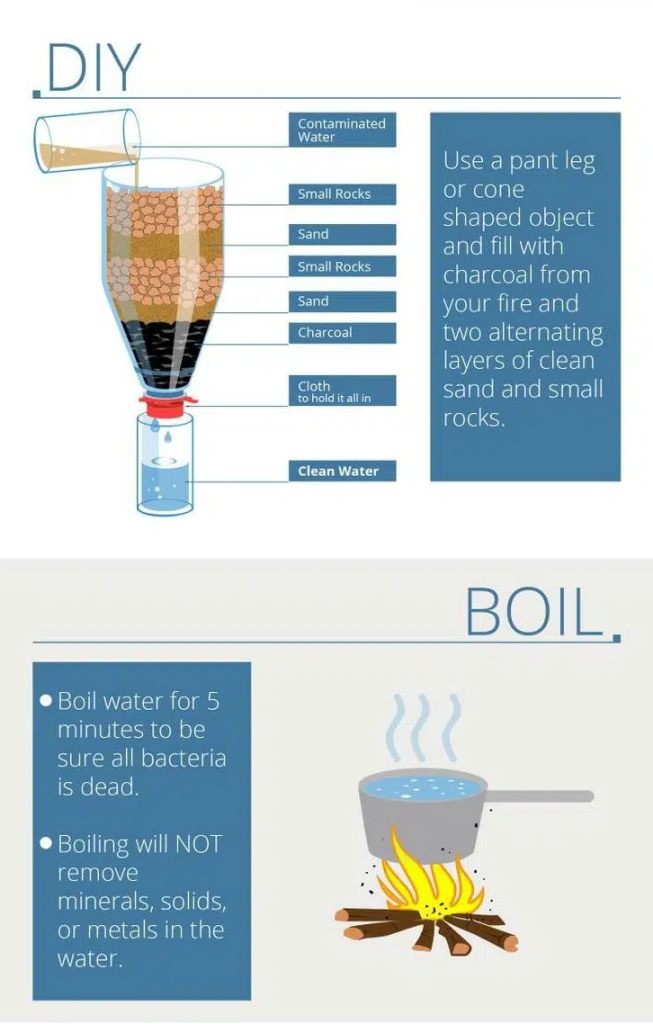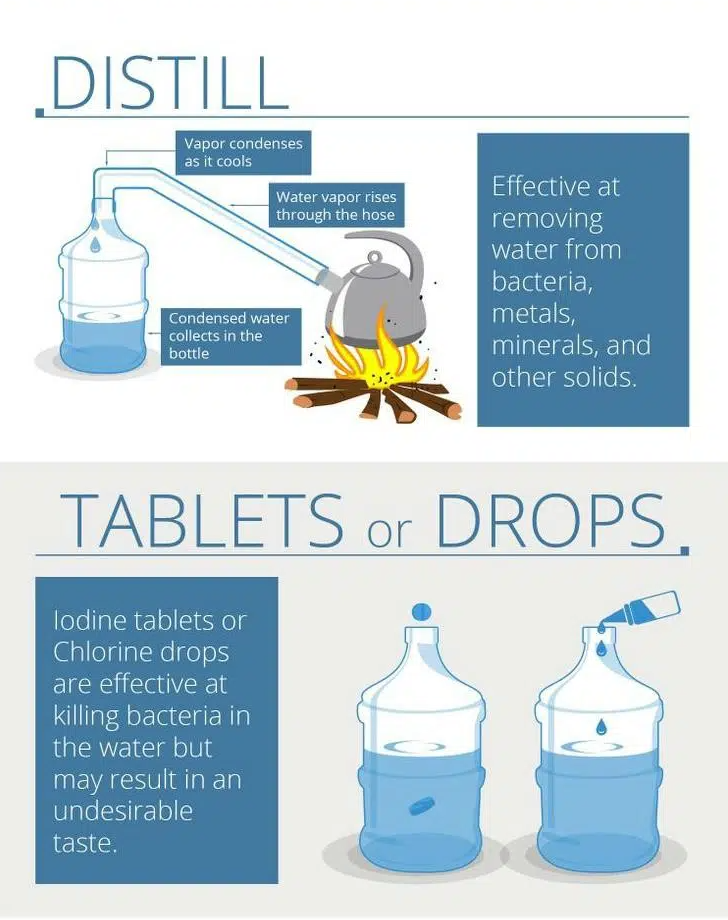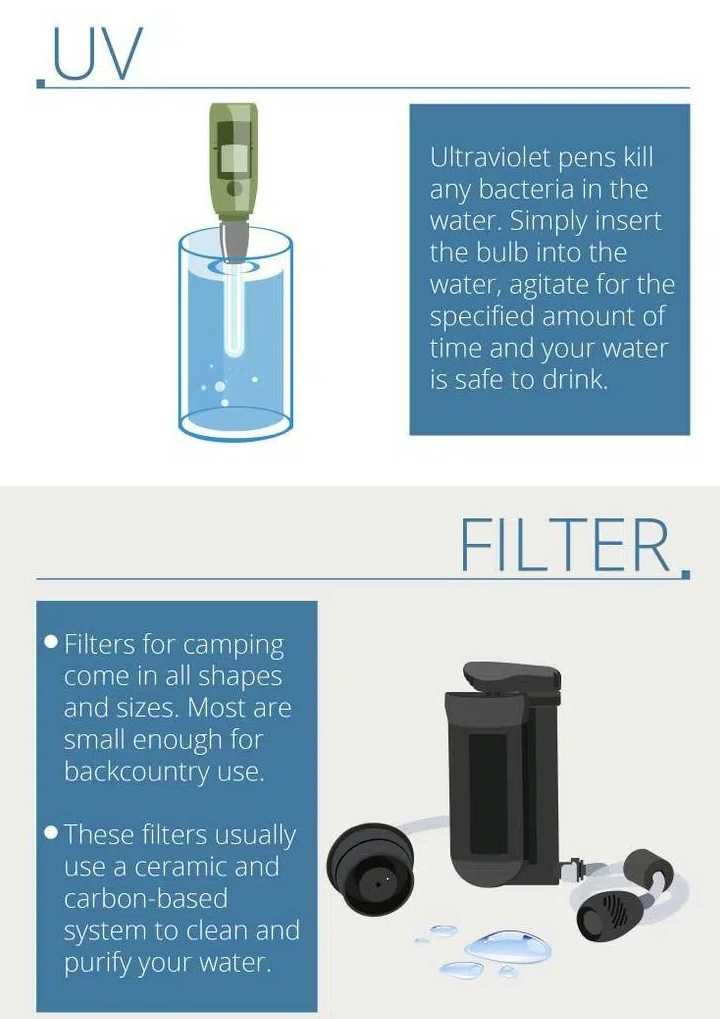Nothing can take the place of water in the natural system. It is the essential ingredient that facilitated the emergence of us, life on Earth, from the primordial soup. Without water, there is no life, and no form of organism can survive without it. This is quite cool when you consider that certain creatures can survive nuclear events but cannot survive without water.
Even the human body is 60% water, which explains why the beverages we consume have such a profound effect on our health and overall mood. As you’re probably aware, water can be both a friend and an adversary to the human organism, which is why you should learn how to purify water (if you don’t already).
Typically, in the aftermath of natural disasters (global or local), water supplies get polluted with a variety of hazardous germs, industrial spills from companies, and burst sewage pipes. This is the primary reason why officials advise residents to avoid drinking from previously deemed safe water sources. They must first test the water to ensure that it remains safe to drink. Consider the potential harm that polluted water might do our body.
All of our tissues are composed of water and must be hydrated in order to survive. Bad water would introduce hazardous bacteria into every region of our body, causing them to spread faster than our immune system could respond.
Having fresh water to drink during a trying period ensures that you have the resources necessary to fight for your life. Our bodies can survive for just around 5 to 10 days without water, however this time duration varies depending on the surrounding environment. It takes between five and ten days under perfect conditions: no stress, no food, and no activity; and these days would be torment since you can literally feel your body drying. Additionally, there may be lasting harm, as some tissues degrade more rapidly in the absence of water.
Under stressful situations, when you must move quickly and think quickly while carrying a large bag on your back, your resistance is no more than two days and a half. If you forgot to carry enough water or find yourself without access to fresh water, filtering water found nearby is the next best option.
Why should you care about purifying water?
If you’re still not convinced about how harmful polluted water may be to your health, allow us to provide an illustration. Consider trekking with a depleted water supply. You come upon a little pond with clear, cool water that appears quite inviting under the scorching July sun. You drink from it (the water appeared to be pure) and even replenish your supply in case you require more till you get home.
From here, it’s all downhill (literally and figuratively). You begin to feel lethargic, your stomach begins to indicate that something is amiss, and after a while, you have severe diarrhea and vomiting. This actually increases the process of dehydration, making you feel increasingly feeble. Finally, you will be unable to continue and will be compelled to seek for assistance. This minor trip will almost certainly result in you being treated for severe dehydration and a variety of germs and parasites.
Now, do the math: if drinking unpurified water on a pleasant summer day can land you in the hospital, what will happen to you in the event of a disaster? Due to hurdles and other issues, assistance may be unable to reach you in a timely manner. As you can see, drinking polluted water accelerates the process of dehydration. Bear in mind that germs and parasites may survive in pure water as well. They are invisible to the human eye. Additionally, you should be aware of the hazards associated with drinking unfiltered water.
To determine if you are dehydrated, you must first understand the three phases of dehydration:
- Mild dehydration — the primary symptoms are decreased saliva and urination, as well as a darker color in the urine.
- Moderate dehydration – dry mouth, your heart will begin to beat quicker in an attempt to maintain body temperature, dry eyes, and a drastic drop in urine;
- Severe dehydration — at this point, your skin will begin to turn grey, you will feel sluggish, and you will have vomiting and diarrhea (ironic, isn’t it? ), you will have no urine remaining, and your skin will feel chilly to the touch.
- You can recover from any of these stages if you receive assistance and water quickly enough. Otherwise, death is the last event.
Hopefully, after reading this, you have a better understanding of the importance of water in our lives and how critical it is to be able to filter your own water.
How to Purify Water: 5 Best Methods of Water Filtering
Our forefathers and mothers were highly imaginative, and upon discovering the importance of water to their bodies, they sought out ways to purify it so they may drink it safely. That is why, whether you are out in the woods or at home, there are various safe options for purifying water nowadays. Each of the ways we will cover is entirely safe and has been tried several times, so you can trust them completely.
First method: boiling water
We are well aware that water boils at a temperature of 100 degrees Celsius (212 Fahrenheit). Additionally, we know that very few germs can withstand temperatures that high for an extended period of time. To summarize, water may be filtered by boiling if the procedure is followed correctly.

- To begin, either create a fire (if you’re in the woods) or light the stove. Light the fire in the pot of water (if you don’t have a pot, use whatever fireproof container you have on hand) and wait for the water to begin to boil (when it starts to make bubbles).
- Continue heating the saucepan until the water begins to boil vigorously, at which point you may begin timing. Allow it to boil for around 5 to 10 minutes, depending on your altitude.
- When the timer sounds, remove the pot from the heat and let it to cool. Additionally, the cooling down phase is beneficial in allowing solid objects to settle to the bottom of the pot. Following this, the water is safe to drink.
Things to keep in mind: Generally, boiling a pot of water for around three minutes eliminates the majority of germs and renders the water safe to consume. Nonetheless, you must bear the following in mind:
Boiling will not remove heavy metal contaminants from water; it is better to let the water boil for at least 5 minutes. Certain compounds are removed by vaporization; the boiling temperature decreases with altitude, which means that boiling becomes inefficient beyond 5500 meters. Additionally, for every 300 meters above sea level, add one additional minute of boiling.
Second method: purification tablets or drops
This is hardly the most appetizing technique of purifying water, but in times of necessity, this is irrelevant. After filtration, tablets or drops impart an unpleasant flavor to the water. There are several drops and pills available, but the most popular are iodine and chlorine tablets. These are commonly seen at adventure stores, as they are mostly utilized by outdoor explorers.
Here are some pointers on how to use them most effectively:
- If there are large particles floating in the water, begin by filtering it (you can use a clean cloth for this). This is the initial step toward filtration and purification of your water. This wonderful step-by-step guide will teach you how to create a water filter out of items you already have.
- The ideal water temperature is around 21 degrees Celsius (68 Fahrenheit). Tablets will be the most effective at this time.
- Avoid using expired or soon-to-expire pills. These will be less effective than fresh ones.
- One table for every fourth of the water volume is the optimal quantity.
- Shake the container to thoroughly dissolve the pills in the water. Wait 30 minutes after the pills are completely dissolved before drinking.
- You should be aware that you must wait approximately one hour before consuming cold water. The cold reduces the effectiveness of the pills.
- Useful tip: If you have any flavorings on hand, such as powdered forest fruit blends, these will help to mask the bitter taste and make the water more drinkable.
Third method: use your wilderness skills to purify water
This approach is useful if you are out in the woods and do not have access to any other means of cleaning water. While the procedure may appear difficult and crazy, it’s important to know how to purify water in the absence of a pot, fire, or tablets.
The procedure involves a few objects found in nature, including birch bark (or any other flexible bark that can be shaped into a cone), a length of rope (or any flexible, strong material that may be used to knot the cone), charcoal, sand, gravel, and grass. Numerous strange objects, correct? How to utilize everything:
- After locating the appropriate sort of bark, cut a piece large enough to form a cone. Tie the cone together with the rope or a tough piece of grass to help it maintain its form.
- Include several layers in the cone to filter and cleanse the water. Layer the sand, charcoal, grass, and gravel in the following order: sand, charcoal, grass, and gravel. Charcoal is particularly excellent in removing impurities from water.
- Water should be poured into a container through the cone. Repeat the procedure at least three or four times to ensure that the majority of the germs have been eliminated.
- Bear in mind that while this procedure is not 100% effective, it will eliminate the majority of germs from your water. If you have a strong immune system, you will easily be able to fend off the remaining ones. In any case, you should avoid using this approach until an emergency arises and you are in desperate need of water.

Fourth method: use the sun to obtain pure water
This is not a practice we encourage using in times of crisis. Purifying water with the sun may be time consuming and the resulting quantity unsatisfactory, so do not rely on it in the event of a crisis. It’s more of a strategy to put to the test while you’re out, embarking on a new trip, and attempting new things.
A huge bowl or receiver with a large aperture and tall walls, a heavy cup that fits within the bowl without being taller than the bowl, transparent wrap, and a large rock are required (and sun, of course).
- Fill the bowl halfway with the water you wish to purify and add the cup. The cup should be sufficiently substantial so that it does not float. Assure that no water enters the cup.
- Wrap the transparent wrap over the bowl, totally enclosing the water and cup.
- Over the cup, place the large rock on top of the transparent wrap.
- Expose the entire arrangement to the sunlight.
- The mechanism is straightforward: the sun’s heat vaporizes the water in the bowl.
However, because of the translucent wrap, the water cannot escape and drops of clear water will collect inside the wrap, sliding to the lowest point (here is where the rock comes in handy) and dropping into the cup. It may take several days to obtain a clean cup of water, which is why this approach is not suggested during times of adversity.
Fifth method: using a water purifier
This may be the quickest and most efficient approach of all. There are several types of water purifiers available, but the most popular is the bottle with an integrated water filter. It’s convenient to bring one with you and adds no additional weight to your backpack. The concept behind this bottle is fairly straightforward: before allowing the water to enter the container, they pass it through a purifier to remove any germs or parasites.

There are various different types of water bottles with an integrated filter on the market, so you may pick one that fits your tastes and budget.
Sixth method: using a UV pen
If you do not have a water bottle of this sort (which we believe you should), you can use other types of water purifiers, such as:
- The UV pen is compact and simple to use. Simply submerge it in water and wait for the light to change to green. When the light turns green, begin churning the water with the pen and continue stirring until the light goes out. Only then is the water safe to drink, since the UV light destroyed all life in the water.
- The gravity fed purifier – this model is fairly huge, making it difficult to transport in a backpack. It’s preferable to utilize it at home or when camping to ensure that you have enough room to transport it.
After illustrating the most often used ways for purifying water, we can definitively state that the most frequently used and fastest approach is the filtering and boiling method. It is preferable to filter the water through a thick, clean cloth to eliminate any large particles such as sand, dirt, or other impurities. This manner, you will avoid having to wait for the water to cool after boiling. Of course, it’s preferable to use a built-in water filter in your bottle, but if you’re in the woods and don’t have that luxury, a good boiling will suffice.
Water is critical in our daily sedentary lives, and we would be unable to carry out our activities if we were dehydrated. When you are in the woods, exerting physical exertion, or attempting to flee a tragedy, your body sweats more. This is our body’s natural cooling system at work, attempting to maintain an appropriate temperature that allows it to function properly.
Without adequate hydration, your heart will work harder and your tissues will lose their strength and elasticity, leaving you feeling unwell and depleted of energy. Water is not an item to overlook when assembling your emergency kit!
Now that you know how to purify water, either with or without the assistance of other materials, you may consider yourself equipped to survive a large-scale calamity. We may not appreciate it, but the fact that we have fresh water at our fingertips is rather remarkable. Nonetheless, it is a disadvantage since we are unprepared to locate and receive fresh water in the event of a disaster. Many individuals do not enjoy being wild and adventurous on vacation, preferring the tranquility of a hotel.
This is a significant disadvantage of survival readiness because it gives the impression that everything is simple and easy to get. Going on an outdoor excursion with your pals may teach you a lot about survival skills and wilderness survival. Perhaps it’s time to rethink your holiday manner, don’t you believe?